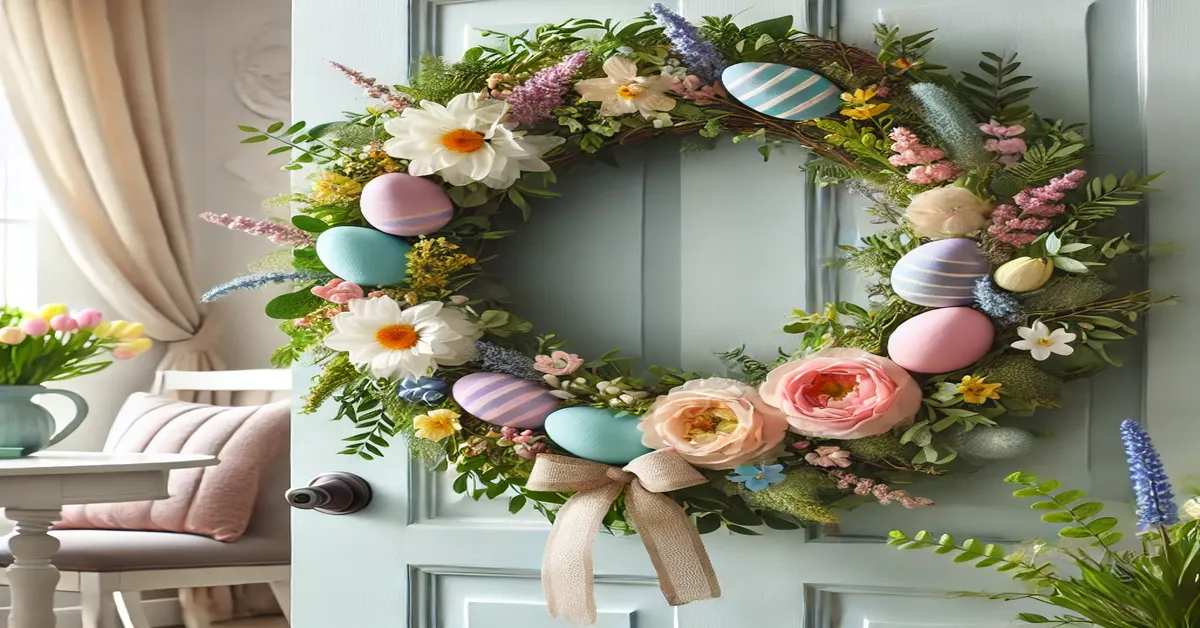LifeStyle
Shop Easter Wreaths: Celebrate Spring with Style and Elegance

Springtime is a season of renewal, growth, and celebration, making it the perfect backdrop for Easter—one of the most cherished holidays of the year. As families gather to commemorate this special time, decorations play a key role in setting the festive mood, and Easter wreaths have become an iconic symbol of the season. These beautifully crafted designs capture the essence of spring with their bright colors, floral elements, and whimsical embellishments. Whether you’re looking to enhance your home’s curb appeal or add a personal touch to your indoor décor, shop Easter wreaths to discover an incredible array of styles, colors, and themes that evoke the joy and renewal of spring. From delicate floral arrangements to vibrant egg-themed designs, Easter wreaths provide a versatile and elegant way to celebrate the season. This comprehensive guide dives into the history of Easter wreaths, explores their many types and uses, and provides practical tips for finding or creating the perfect piece to elevate your holiday décor.
The History of Easter Wreaths
Easter wreaths have evolved from ancient traditions that celebrated the arrival of spring. In many cultures, wreaths symbolize the cycle of life, renewal, and hope—themes that align perfectly with the Easter holiday. Initially made from natural elements like fresh flowers, leaves, and twigs, these wreaths have transformed over time to incorporate colorful eggs, ribbons, and other festive embellishments.
Why Shop Easter Wreaths?
Shopping for Easter wreaths allows you to choose from an incredible array of designs and materials. Whether you prefer something traditional, modern, or whimsical, there’s a wreath to suit every taste. Here are a few reasons why you should shop Easter wreaths:
- Celebrate Spring: Easter wreaths capture the essence of spring with their vibrant colors and floral elements.
- Versatile Décor: These wreaths can be used indoors or outdoors, making them versatile for any setting.
- Customizable: Many wreaths allow for personalization, enabling you to create a unique centerpiece for your home.
- Affordable Options: With options ranging from budget-friendly to luxurious, there’s a wreath for every price point.
Types of Easter Wreaths
When you shop Easter wreaths, you’ll encounter a variety of styles and themes. Here’s a breakdown of the most popular types:
1. Floral Easter Wreaths
Floral wreaths are a classic choice for Easter. Made with fresh or artificial flowers, they often feature pastel shades like pink, yellow, and lavender. Popular blooms include tulips, daffodils, and lilies.
2. Egg-Themed Wreaths
Eggs are a symbol of new life and are closely associated with Easter. Egg-themed wreaths incorporate colorful or speckled eggs as decorative elements, often paired with greenery and ribbons.
3. Bunny Wreaths
Playful and whimsical, bunny-themed wreaths are perfect for families with children. These wreaths often include bunny shapes, ears, or plush toys as focal points.
4. Rustic Wreaths
For a natural and earthy look, rustic wreaths made from twigs, burlap, and muted colors provide a charming touch. These are ideal for farmhouse-style homes.
5. Religious Wreaths
For those who wish to emphasize the spiritual aspect of Easter, religious wreaths featuring crosses, doves, or inspirational messages are a meaningful choice.
6. DIY Wreaths
If you enjoy crafting, creating your own Easter wreath can be a fun and rewarding project. DIY kits are also available for those who want a hands-on experience.
How to Shop Easter Wreaths
Shopping for the perfect Easter wreath involves considering factors like material, size, and design. Here’s a step-by-step guide to help you make the best choice:
1. Determine Your Style
Think about the overall theme of your Easter decorations and choose a wreath that complements your style. Whether you prefer traditional floral arrangements or quirky bunny designs, your wreath should align with your personal taste.
2. Decide on Placement
Will your wreath be displayed indoors or outdoors? Outdoor wreaths need to be durable and weather-resistant, while indoor wreaths can focus more on intricate designs and delicate materials.
3. Consider Size
The size of your wreath should match the space where it will be displayed. Measure your door, wall, or table to ensure the wreath fits perfectly.
4. Choose Materials
From natural greenery to synthetic fabrics, Easter wreaths come in a range of materials. Artificial wreaths are long-lasting and low-maintenance, while natural ones offer an authentic look and feel.
5. Explore Customization Options
Many stores and online platforms allow you to customize your wreath with personalized messages, monograms, or specific color schemes.
6. Set a Budget
Establish a budget before you shop Easter wreaths. This will help narrow down your options and ensure you find something within your price range.
Where to Shop Easter Wreaths
There are countless places to shop Easter wreaths, both online and in physical stores. Here are some popular options:
1. Online Retailers
Platforms like Amazon, Etsy, and Wayfair offer a wide selection of Easter wreaths. Online shopping provides the convenience of browsing multiple styles and comparing prices from the comfort of your home.
2. Local Craft Stores
Stores like Michaels, Hobby Lobby, and Joann Fabrics often stock seasonal wreaths and DIY kits. Shopping locally allows you to see the wreaths in person and gather inspiration for your décor.
3. Florists and Garden Centers
For fresh floral wreaths, visit your local florist or garden center. These wreaths are perfect for adding a touch of natural beauty to your home.
4. Specialty Boutiques
Many small businesses and specialty shops create handcrafted Easter wreaths with unique designs. Supporting these shops not only provides you with a distinctive piece but also helps local artisans.
Styling Tips for Easter Wreaths
Once you’ve found the perfect wreath, styling it effectively will enhance its impact. Here are some tips:
1. Use as a Centerpiece
Place a wreath on your dining table and add a candle or floral arrangement in the center for a stunning Easter centerpiece.
2. Pair with Other Decorations
Combine your wreath with other Easter décor, such as garlands, figurines, or string lights, to create a cohesive look.
3. Layer with Ribbons and Bows
Add ribbons, bows, or other embellishments to your wreath for a personalized touch.
4. Experiment with Locations
While doors are the most common spot for wreaths, consider hanging them on windows, walls, or even fences for a unique display.
Caring for Your Easter Wreath
To keep your Easter wreath looking fresh and vibrant, follow these care tips:
1. For Artificial Wreaths
- Dust regularly to maintain cleanliness.
- Store in a cool, dry place to prevent damage.
- Avoid prolonged exposure to direct sunlight to prevent fading.
2. For Fresh Wreaths
- Mist lightly with water to keep flowers hydrated.
- Display in a shaded area to extend freshness.
- Dispose of responsibly once it begins to wilt.
DIY Easter Wreath Ideas
Creating your own Easter wreath is a wonderful way to add a personal touch to your decorations. Here are some ideas:
1. Eggshell Wreath
Use painted eggshells and hot glue to craft a colorful and eco-friendly wreath.
2. Fabric Scrap Wreath
Repurpose old fabric scraps into a charming, rustic wreath by tying them around a wire frame.
3. Bunny-Themed Wreath
Add felt bunny shapes and faux fur to a simple wreath base for a playful design.
4. Floral Hoop Wreath
Attach flowers and greenery to a metallic hoop for a minimalist yet elegant look.
Conclusion
Easter wreaths are far more than mere decorations; they are vibrant expressions of joy, renewal, and creativity that resonate deeply with the spirit of spring. Each wreath tells a story—a story of blooming life, bright colors, and cherished traditions. Whether you choose to shop Easter wreaths from a store or craft your own personalized masterpiece, these stunning pieces transform your home into a celebration of the season. Hanging an Easter wreath is not just about enhancing your décor; it’s about creating a welcoming ambiance that embodies the optimism and energy of spring. With countless styles, materials, and customization options available, ranging from pastel floral arrangements to whimsical bunny and egg-themed designs, there’s truly a wreath to cater to every preference, budget, and creative vision. Display them on your doors, walls, or even use them as a centerpiece to elevate your Easter festivities. Embrace the joy of the season with a wreath that reflects your personality and sets the perfect tone for family gatherings, celebrations, or quiet moments of springtime reflection.
Read: 718 Area Code: The Numbers That Shaped NYC’s Outer Boroughs
FAQs
1. What materials are commonly used in Easter wreaths?
Easter wreaths can be made from fresh flowers, artificial blooms, twigs, ribbons, eggshells, and other decorative elements.
2. Where can I shop Easter wreaths online?
You can find Easter wreaths on platforms like Amazon, Etsy, and Wayfair, as well as specialty boutique websites.
3. How do I care for a fresh Easter wreath?
Mist the wreath lightly with water, keep it in a shaded area, and dispose of it responsibly once it wilts.
4. Are there affordable options for Easter wreaths?
Yes, you can find budget-friendly wreaths at local craft stores, online retailers, and even DIY kits for crafting your own.
5. Can I customize an Easter wreath?
Many retailers offer customization options, allowing you to personalize your wreath with colors, messages, and embellishments.
6. What are some creative ways to display Easter wreaths?
Aside from doors, you can hang wreaths on windows, walls, fences, or use them as table centerpieces.
LifeStyle
The Daily Keeper: A Guide to Balancing Life’s Responsibilities

In a world that seems to move faster with each passing day, the concept of a “daily keeper” has become more essential than ever. Whether it’s about managing your schedule, staying on top of priorities, or simply finding time for yourself, being a daily keeper’s means maintaining balance and control over life’s demands. But what exactly does it mean to embrace this role, and how can one excel at it? This article delves into the philosophy of being a daily’s keeper, offering insights and practical advice to help you thrive.
What is a Daily Keeper?
The term “daily keeper” refers to someone who takes charge of their day with intentionality, planning, and focus. It’s about being the steward of your time and energy, ensuring that each day aligns with your long-term goals and values. A daily’s keeper isn’t just someone who checks tasks off a to-do list—it’s someone who approaches life with mindfulness and purpose.
In today’s fast-paced society, distractions are everywhere. From social media notifications to work demands, it’s easy to feel pulled in a million directions. The daily’s keeper mindset helps counteract this chaos by fostering a sense of clarity and direction.
The Importance of Being a Daily Keeper
Taking on the role of a daily keeper’s offers numerous benefits, including:
- Improved Productivity: By organizing your day, you can accomplish more in less time.
- Reduced Stress: Knowing what needs to be done eliminates the anxiety of forgetting important tasks.
- Greater Life Satisfaction: When you live with intention, you’re more likely to feel fulfilled.
- Enhanced Time Management: A daily keeper’s knows how to prioritize and allocate time effectively.
Building a Daily Keeper Routine
Creating a daily keeper routine doesn’t have to be complicated. Here are some steps to get started:
1. Morning Preparation
The way you start your day sets the tone for everything that follows. As a daily keeper’s, begin each morning with a clear plan. Take a few minutes to review your schedule, prioritize your tasks, and set realistic goals.
2. Use Tools to Stay Organized
There are countless tools available to help you manage your day. Planners, digital calendars, and productivity apps can serve as your daily keeper’s companions. Find what works best for you and stick to it.
3. Prioritize Tasks
Not all tasks are created equal. A daily keeper’s knows how to differentiate between what’s urgent and what’s important. Focus on high-priority tasks first, and tackle less critical ones as time allows.
4. Take Breaks
Being a daily keeper doesn’t mean working nonstop. Regular breaks are essential for maintaining focus and preventing burnout. Use techniques like the Pomodoro Method to balance work and rest.
5. Reflect on Your Day
At the end of each day, take a moment to reflect. What went well? What could have been improved? This practice not only helps you learn but also ensures that tomorrow is even more productive.
Overcoming Challenges as a Daily Keeper
While the daily’s keeper lifestyle has many benefits, it’s not without its challenges. Here are some common obstacles and how to overcome them:
1. Procrastination
Procrastination is the enemy of productivity. To combat it, break tasks into smaller, manageable steps and set deadlines for each one.
2. Overcommitment
It’s tempting to say yes to every opportunity, but overcommitting can lead to burnout. A daily keeper’s knows their limits and isn’t afraid to say no when necessary.
3. Distractions
Distractions are inevitable, but they can be managed. Create a distraction-free workspace and use techniques like time blocking to stay focused.
4. Perfectionism
Striving for perfection can be paralyzing. Remember, being a daily keeper’s is about progress, not perfection. Focus on completing tasks rather than making them flawless.
The Daily Keeper Mindset
Being a daily keeper’s is as much about mindset as it is about strategy. Here are some principles to adopt:
- Embrace Flexibility: Life is unpredictable. A good daily keeper’s adapts to changes with grace.
- Practice Gratitude: Take time to appreciate what you’ve accomplished and what you have.
- Stay Present: Focus on the task at hand rather than worrying about the past or future.
- Celebrate Small Wins: Every step forward is a victory. Acknowledge and celebrate your progress.
Daily Keeper Tools and Resources
To excel as a daily keeper’s, consider using the following tools:
- Planners and Journals: Tools like the Passion Planner or bullet journals are great for organizing tasks and tracking progress.
- Apps: Digital tools like Todoist, Trello, and Notion can help you stay on top of your commitments.
- Time Management Techniques: Methods like time blocking, the Eisenhower Matrix, and the 80/20 rule can enhance your efficiency.
Real-Life Examples of Daily Keepers
Many successful people embody the daily keeper philosophy. From entrepreneurs to athletes, the ability to manage one’s day effectively is a common trait among high achievers. Take, for example, Elon Musk, who famously uses time blocking to structure his day down to five-minute intervals. While you don’t need to go to such extremes, adopting a similar approach can work wonders.
Daily Keeper and Work-Life Balance
One of the greatest challenges in modern life is achieving work-life balance. As a daily’s keeper, you have the tools to create boundaries and ensure that neither work nor personal life takes precedence over the other. Schedule time for hobbies, family, and self-care—and stick to those commitments.
The Role of Self-Care in Being a Daily Keeper
Self-care is an essential part of the daily keeper lifestyle. It’s impossible to manage your day effectively if you’re running on empty. Prioritize activities that recharge you, whether it’s exercise, meditation, or simply spending time in nature.
Daily Keeper in the Digital Age
The digital age has made it both easier and harder to be a daily keeper. On one hand, technology provides incredible tools for organization and productivity. On the other hand, it introduces countless distractions. The key is to use technology mindfully, leveraging its benefits while minimizing its downsides.
Conclusion
The role of a daily keeper is not just about managing time—it’s about living with intention and purpose. By adopting the principles and strategies outlined in this article, you can take control of your days and create a life that aligns with your values and goals. Remember, the journey to becoming a daily keeper is a process, not a destination. Start small, stay consistent, and watch as your life transforms.
FAQs
1. What does it mean to be a daily keeper?
A daily keeper is someone who takes charge of their day with intentionality, planning, and focus to achieve balance and productivity.
2. What tools can help me be a better daily keeper?
Tools like planners, productivity apps (e.g., Todoist, Trello), and time management techniques (e.g., time blocking) can be incredibly helpful.
3. How can I overcome procrastination as a daily keeper?
Break tasks into smaller steps, set deadlines, and focus on making progress rather than achieving perfection.
4. Can anyone become a daily keeper?
Yes, with practice and commitment, anyone can adopt the daily keeper mindset and improve their ability to manage their days.
5. How does being a daily keeper improve work-life balance?
By prioritizing and scheduling time for both work and personal activities, a daily keeper ensures that neither aspect dominates the other.
6. Why is self-care important for a daily keeper?
Self-care ensures that you have the energy and focus needed to manage your day effectively and avoid burnout.
-

 Guide2 months ago
Guide2 months agoTikTok Emojis: A Comprehensive Guide to Expression on TikTok
-

 Celebrity2 months ago
Celebrity2 months agoTottenham Standings: Exploration of the Club’s Journey, Challenges, and Future
-

 Education2 months ago
Education2 months agoGuide to Wordle Answer Today: Daily Word Puzzle Phenomenon
-

 Guide2 months ago
Guide2 months agoGuide to CSUF Jobs: Opportunities, Benefits, Application Process
-

 Technology2 months ago
Technology2 months agoEscort Babylon: Bridging Connectivity & Opportunity in Digital Age
-

 Celebrity2 months ago
Celebrity2 months agoSkylarmaexo: A Rising Star in the TikTok Universe
-

 Celebrity2 months ago
Celebrity2 months agoJack Posobiec: A Controversial Political Figure Shaping Far-Right Discourse
-

 Business2 months ago
Business2 months agoFisker Stock: Challenges and Opportunities in the EV Market




